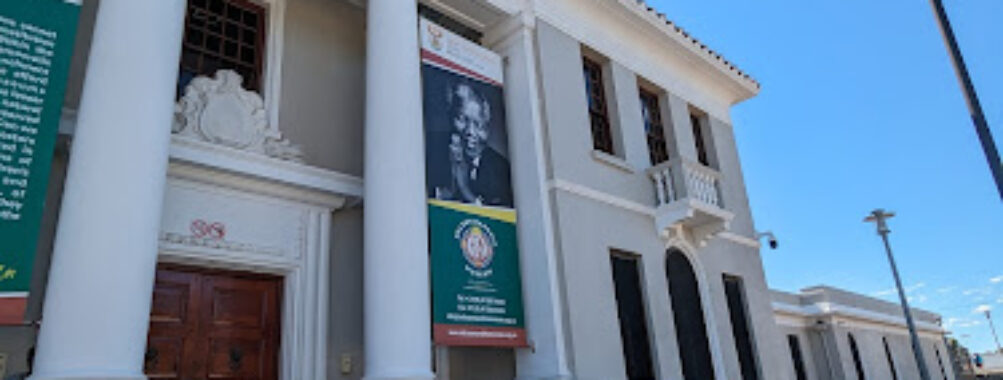
Nelson Mandela Museum
“`html
Table of Contents
Description
The Nelson Mandela Museum in South Africa is not your average museum experience; it’s more like stepping into someone’s life story, piece by piece. Spread across three key sites in the Eastern Cape – the Bhunga Building in Mthatha, the Youth and Heritage Centre in Qunu, and Mandela’s birthplace at Mvezo – the museum gives travelers a chance to connect with Mandela’s journey in a deeply personal way. Each site has its own flavor: the Bhunga Building houses exhibitions and personal artifacts, Qunu offers a look at his childhood environment, and Mvezo takes you right back to his roots. Together, they tell a story that is both intimate and monumental.
Visitors often describe the museum as thought-provoking, sometimes even emotional. And honestly, that makes sense. Walking through the exhibits, you’re not just learning about a political leader; you’re seeing the struggles, the resilience, and the everyday moments of a man who shaped a nation. Of course, like any place, it’s not perfect. Some travelers feel the displays could be updated or more interactive, while others rave about the authenticity and the sense of history in the air. Personally, I think that’s part of the charm – it’s not a glossy, overproduced attraction. It feels real, grounded, and true to Mandela’s life.
One of the things I found striking when I visited was how the museum balances the heavy weight of history with small, human touches. For example, seeing photos of Mandela as a boy in Qunu made me think about my own childhood and how far we all travel, in one way or another, from where we began. It’s a place that makes you reflect – not just on Mandela’s story, but on your own path too.
Key Features
- Three distinct sites: Bhunga Building in Mthatha, Qunu Youth and Heritage Centre, and Mandela’s birthplace in Mvezo.
- Exhibitions featuring personal items, gifts Mandela received as president, and extracts from his autobiography.
- Guided tours of Qunu, including his childhood school and the rolling hills where he herded cattle.
- Wheelchair-accessible parking and family-friendly facilities, including changing tables.
- Opportunities to learn about South Africa’s liberation struggle through Mandela’s personal lens.
- A chance to see how Mandela lived as a child, far removed from the global stage he later occupied.
Best Time to Visit
If you’re wondering when to plan your trip, the best time generally falls between May and September, which is South Africa’s dry season. The weather is cooler and the roads are easier to navigate, especially if you’re heading into the rural areas around Qunu and Mvezo. That said, if you prefer a quieter experience, visiting outside of school holidays is a smart move. I once went in July, and while it was a bit chilly, the crisp air and calm atmosphere made the whole visit feel even more reflective. Summers can be hot and a little overwhelming, but they do bring a certain energy if you don’t mind the heat.
How to Get There
Reaching the Nelson Mandela Museum depends on which site you want to start with. Most visitors begin at the Bhunga Building in Mthatha, which is accessible by road and has decent infrastructure for travelers. From there, it’s about a 30-minute drive to Qunu, where you can explore the heritage centre and Mandela’s childhood village. Mvezo is a bit more remote, so prepare for a longer drive and less predictable road conditions. Renting a car is the most practical option, though guided tours are also available if you’d rather not handle the logistics yourself. Public transport is limited, so self-drive or organized tours really are the way to go.
When I drove from East London to Mthatha, I’ll admit the journey felt long, but the scenery more than made up for it. Rolling hills, scattered villages, and the occasional herd of goats crossing the road – it’s all part of the adventure. Just make sure you’ve got a good playlist and maybe some snacks, because the drive is as much a part of the experience as the destination.
Tips for Visiting
Here are a few things I wish I’d known before my first visit – and they might save you some time (and stress):
- Book tickets in advance: While it’s not always crowded, having your tickets sorted makes the process smoother.
- Bring cash: Card machines can be unreliable in rural areas, so it’s handy to have some cash for small purchases or tips.
- Wear comfortable shoes: Especially if you’re heading to Qunu, where you’ll likely be walking around the village and fields.
- Allow enough time: Don’t rush. Each site has its own story, and you’ll want at least a full day if you’re covering more than one location.
- Travel with curiosity: Some exhibits may feel simple compared to big-city museums, but the heart of the experience lies in the stories and the setting.
- Ask questions: The guides are often locals who grew up in the area, and their personal insights bring the history to life in ways a plaque on the wall never could.
One last piece of advice – take a moment to just stand still and look around, especially in Qunu. The hills stretch out in every direction, and it’s easy to imagine a young Mandela running through the grass, completely unaware of the extraordinary life ahead of him. That’s the kind of perspective you won’t get from reading a book or watching a documentary. It’s something you feel in your bones when you’re there, and honestly, it’s worth the trip for that moment alone.
“`
Location
Places to Stay Near Nelson Mandela Museum
Find and Book a Tour
Explore More Travel Guides
No reviews found! Be the first to review!